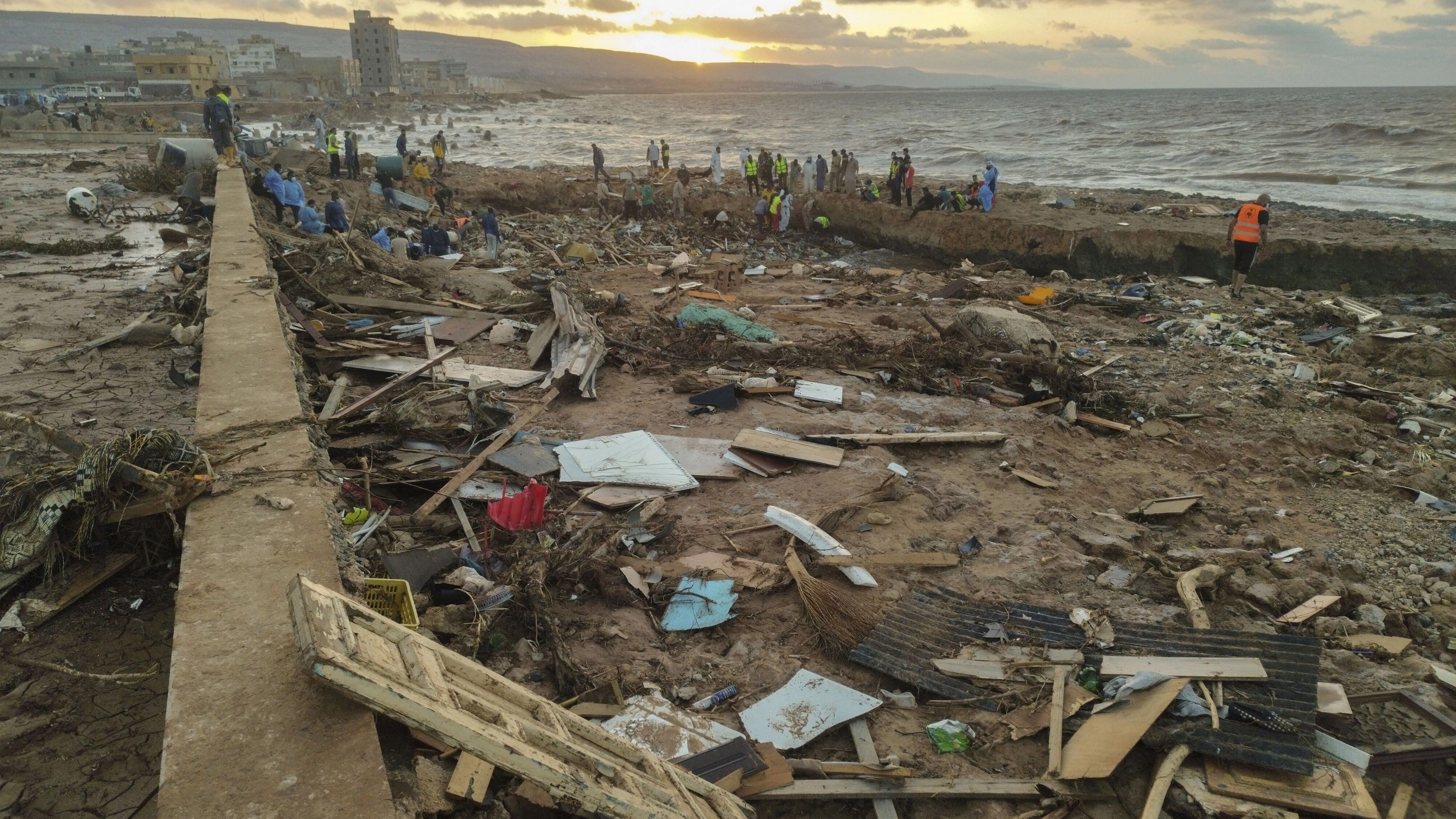
Rescuers and relatives search for bodies of the flood victims at the Corniche of the city of Derna, Libya, Friday, Sept. 15, 2023. The death toll in Libya's coastal city of Derna has as search efforts continue following a massive flood fed by the breaching of two dams in heavy rains, the Libyan Red Crescent.
Credit:PTI/AP
Nearly a week after a powerful storm caused catastrophic flooding in northeastern Libya, rescue groups assessing the damage left behind after two dams collapsed in the city of Derna — washing entire neighborhoods out to sea — said the death toll was still being assessed amid diminishing hopes for finding survivors.
“There are still bodies in the water,” said Salem Al Naas, a spokesperson for the Libyan Red Crescent in Derna, adding in an interview that workers were still searching hundreds of buildings where families were feared to have died.
People are being found alive — one person was pulled from the rubble yesterday, Al Naas said. “But the chance to find survivors is very low,” he said.
The United Nations said Saturday that at least 11,300 people had died and that more than 10,000 people were still missing, citing figures it said were from the Libyan Red Crescent. But Al Naas walked that back a bit, and said that although those numbers “might be an approximate number,” the final death toll is yet unknown. “We just think that the number will be huge,” he said.
The tragedy has spurred a dire humanitarian crisis, displacing more than 40,000 people, according to the International Organization of Migration, leaving survivors suffering a shortage of medical supplies and having to deal with contaminated drinking water. Authorities have turned their focus to taking health precautions, fearing that conditions in the disaster zone could cause diseases to spread. Among the dangers facing those affected by the storm are waterborne diseases, and nearly 300,000 children faced “increased risk of diarrhea and cholera, dehydration and malnutrition,” the U.N. report said.
Beginning Sunday, vaccinations would be given to select groups, including teams exhuming bodies, health workers and children, Othman Abduljalil, health minister for the eastern Libyan government, said in a news briefing late Saturday. But he did not specify which vaccines would be offered or which diseases they were targeting.
The country is split between two rival governments: one in the west and the other in the east, where the floods hit, complicating relief efforts.
Concerns over water contamination also led Prime Minister Abdul Hamid Dbeiba, head of the Tripoli-based western government, on Sunday to order that drinking water be provided to flood-affected areas. Before the prime minister’s order, people had been using drinking water brought in by aid groups, according to Al Naas.
Derna residents had been advised to drink bottled water after some people had become ill, according to health officials.
“People in Derna are advised not to use regular drinking water because it is the most common source of infection,” one of the officials, Haider Al-Sayeh, said in an earlier briefing Saturday, adding that 150 people had experienced diarrhea after consuming the contaminated water.
Amid other water contamination worries, workers were also spraying insecticides inside houses and on submerged bodies, Al Naas said.
“We are expecting negative things will happen,” he said. “We are taking precautions right now.”
Bodies in natural disasters do not generally pose health risks, the World Health Organization has said, but if they are in or near water supplies, there is a risk of contamination.
In its accounting of casualties, Libyan authorities have given varying and more conservative statistics, this past week putting them at more than 3,000 people dead and more than 4,000 missing. The World Health Organization said Saturday that it had helped authorities identify nearly 4,000 bodies.
International groups and officials who arrived in Derna over the weekend to assess the situation said they were aghast by the sheer damage left after the dams’ collapse. The ensuing torrent, local authorities said, crushed bridges and roads, and carried buildings out to sea with people still inside.
A shipment of nearly 32 tons of health supplies — including body bags and essential medical supplies — arrived Saturday in Benghazi, the World Health Organization said. Volunteers were also distributing food to those in nearby areas such as the city of Sousse.
Academics had warned before the disaster that storms could overwhelm the dams protecting Derna, leaving the city vulnerable to flood risk. Climate change had hardened the land, making it less absorbent of runoff water, and experts have argued that the dam was built by engineers who had not accounted for the increasing likelihood of more intense storms. The risks were compounded, experts said, by the neglect of local authorities in maintaining the dam as the country endured political strife, with one government based in the east and another in the west.
“This crisis is beyond Libya’s capacity to manage, it goes beyond politics and borders,” said Abdoulaye Bathily, head of the United Nations’ support mission in Libya, who visited the city Saturday, describing the magnitude of the disaster.
The toll of the tragedy has left Al Naas and others in Derna feeling “on the edge of death,” he said.
“How to deal with this trauma, with people who lost their families?” he said. “Logistic support is good — but what’s next?”